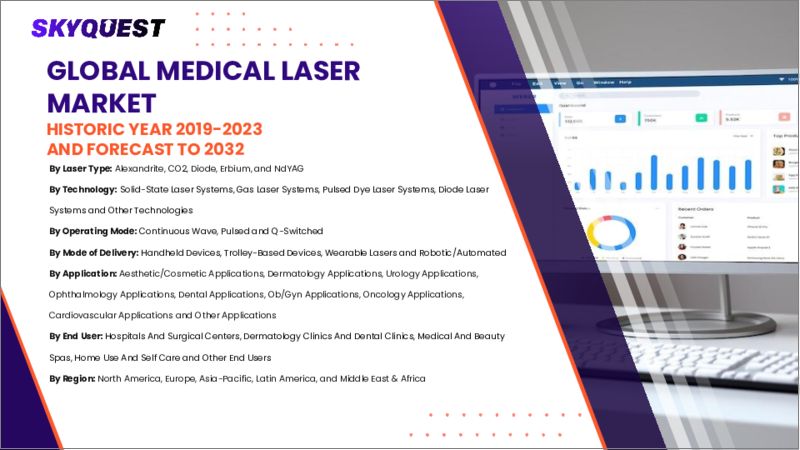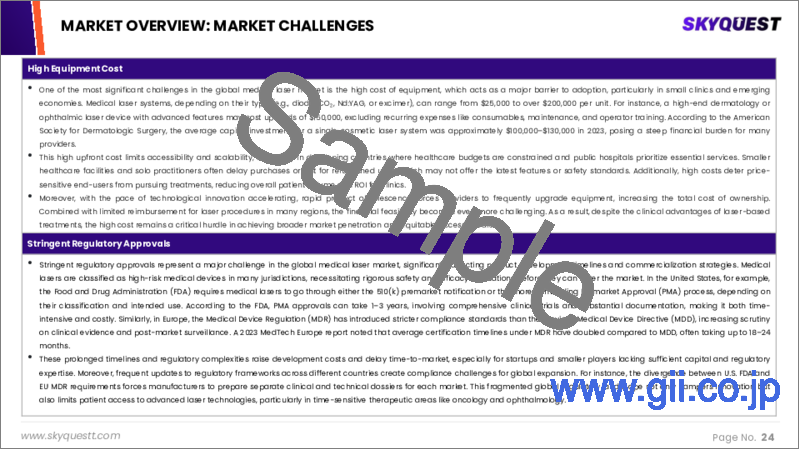|
|
市場調査レポート
商品コード
1619098
医療レーザー市場規模、シェア、成長分析、技術別、用途別、エンドユーザー別、地域別 - 産業予測、2024~2031年Medical Laser Market Size, Share, Growth Analysis, By Technology (Solid-State Laser Systems, Gas Laser Systems), By Application (Aesthetic/Cosmetic Applications, Dermatology Applications), By End User, By Region - Industry Forecast 2024-2031 |
||||||
|
|||||||
| 医療レーザー市場規模、シェア、成長分析、技術別、用途別、エンドユーザー別、地域別 - 産業予測、2024~2031年 |
|
出版日: 2024年12月19日
発行: SkyQuest
ページ情報: 英文 157 Pages
納期: 3~5営業日
|
全表示
- 概要
- 目次
医療レーザーの世界市場規模は、2022年に47億5,000万米ドルと評価され、2023年の53億4,000万米ドルから2031年には137億1,000万米ドルに成長し、予測期間(2024-2031年)のCAGRは12.5%で成長する見通しです。
医療レーザー技術市場は、皮膚科、心臓血管治療、泌尿器科、眼科、美容整形など、さまざまな医療専門分野における非侵襲的治療に対する需要の高まりによって力強い成長を遂げています。この技術により、正確で痛みのない処置が可能になり、迅速な治癒が促進され、従来の手術に代わるものを求める患者を惹きつけています。眼疾患の有病率の増加、美容治療の動向、新興国での医療ツーリズムの拡大などの要因が、市場の潜在力をさらに高めています。特に、レーザー機器は、その有効性、使いやすさ、最小限の侵襲性により、好まれるようになってきています。しかし、レーザー手術に伴う高額な費用と潜在的な合併症が、より広範な普及を妨げる可能性があります。継続的な技術革新と特殊なレーザーシステムのイントロダクションが市場成長を促進することが期待されます。
目次
イントロダクション
- 調査の目的
- 調査範囲
- 定義
調査手法
- 情報調達
- 二次データと一次データの方法
- 市場規模予測
- 市場の前提条件と制限
エグゼクティブサマリー
- 世界市場の見通し
- 供給と需要の動向分析
- セグメント別機会分析
市場力学と見通し
- 市場概要
- 市場規模
- 市場力学
- 促進要因と機会
- 抑制要因と課題
- ポーターの分析
主な市場の考察
- 重要成功要因
- 競合の程度
- 主な投資機会
- 市場エコシステム
- 市場の魅力指数(2023年)
- PESTEL分析
- マクロ経済指標
- バリューチェーン分析
- 価格分析
- 技術の進歩
- 規制情勢
医療レーザー市場規模:技術別およびCAGR(2024~2031年)
- 市場概要
- 固体レーザーシステム
- Er:YAGレーザーシステム
- Ng:YAGレーザーシステム
- Ho:YAGレーザーシステム
- アレキサンドライトレーザーシステム
- リン酸チタンカリウム(KTP)
- ルビーレーザー
- その他ソリッドレーザーシステム
- ガスレーザーシステム
- CO2レーザーシステム
- アルゴンレーザーシステム
- クリプトンレーザーシステム
- エキシマレーザーシステム
- その他のガスレーザーシステム
- パルス色素レーザーシステム
- ダイオードレーザーシステム
- その他の技術
医療レーザー市場規模:用途別およびCAGR(2024~2031年)
- 市場概要
- 美容/化粧品用途
- 脱毛
- ニキビと傷跡の除去
- タトゥー除去
- その他の美的用途
- 皮膚科用途
- 泌尿器科用途
- 眼科用途
- 歯科用途
- 産婦人科用途
- 腫瘍学用途
- 心臓血管用途
- その他の用途
医療レーザー市場規模:エンドユーザー別およびCAGR(2024~2031年)
- 市場概要
- 病院および外科センター
- 皮膚科・歯科
- メディカル&ビューティースパ
- 家庭での使用とセルフケア
- その他のエンドユーザー
医療レーザー市場規模およびCAGR(2024~2031年)
- 北米
- 米国
- カナダ
- 欧州
- ドイツ
- スペイン
- フランス
- 英国
- イタリア
- その他欧州地域
- アジア太平洋地域
- 中国
- インド
- 日本
- 韓国
- その他アジア太平洋地域
- ラテンアメリカ
- ブラジル
- その他ラテンアメリカ地域
- 中東・アフリカ
- GCC諸国
- 南アフリカ
- その他中東・アフリカ
競合情報
- 上位5社の比較
- 主要企業の市場ポジショニング(2023年)
- 主な市場企業が採用した戦略
- 市場の最近の動向
- 企業の市場シェア分析(2023年)
- 主要企業の企業プロファイル
- 会社概要
- 製品ポートフォリオ分析
- セグメント別シェア分析
- 収益の前年比比較(2021~2023年)
主要企業プロファイル
- Boston scientific corporation
- Johnson & johnson vision care, inc.
- Alcon inc.
- Cynosure
- Carl zeiss meditec ag
- Candela corporation
- Lumenis be ltd.
- Cutera, inc.
- Bausch health companies inc.
- El.en. S.p.a.
- Alma lasers
- Fotona
- Aerolase corp.
- Sciton
- Lutronic
- Ipg photonics corporation
- Bison medical.
- Amd lasers
- Zolar technology & mfg. Co. Inc.
- Iridex corporation
結論と推奨事項
Global Medical Laser Market size was valued at USD 4.75 billion in 2022 and is poised to grow from USD 5.34 billion in 2023 to USD 13.71 billion by 2031, growing at a CAGR of 12.5% during the forecast period (2024-2031).
The medical laser technology market is experiencing robust growth driven by the rising demand for non-invasive treatments across various medical specialties, including dermatology, cardiovascular care, urology, ophthalmology, and cosmetic procedures. The technology allows for precise, painless procedures, promoting rapid healing and attracting patients seeking alternatives to traditional surgery. Factors such as the increasing prevalence of eye disorders, the trend towards aesthetic treatments, and the expansion of medical tourism in developing countries further bolster market potential. Notably, laser devices are gaining preference due to their effectiveness, ease of use, and minimal invasiveness. However, high costs and potential complications associated with laser surgeries may hinder broader adoption. Continued innovation and the introduction of specialized laser systems promise to enhance market growth.
Top-down and bottom-up approaches were used to estimate and validate the size of the Global Medical Laser market and to estimate the size of various other dependent submarkets. The research methodology used to estimate the market size includes the following details: The key players in the market were identified through secondary research, and their market shares in the respective regions were determined through primary and secondary research. This entire procedure includes the study of the annual and financial reports of the top market players and extensive interviews for key insights from industry leaders such as CEOs, VPs, directors, and marketing executives. All percentage shares split, and breakdowns were determined using secondary sources and verified through Primary sources. All possible parameters that affect the markets covered in this research study have been accounted for, viewed in extensive detail, verified through primary research, and analyzed to get the final quantitative and qualitative data.
Global Medical Laser Market Segmental Analysis
Global Medical Laser Market is segmented by technology, application, end user and region. Based on technology, the market is segmented into solid-state laser systems, gas laser systems, pulsed dye laser systems, diode laser systems and other technologies. Based on application, the market is segmented into aesthetic/cosmetic applications, dermatology applications, urology applications, ophthalmology applications, dental applications, OB/GYN applications, oncology applications, cardiovascular applications and other applications. Based on end user, the market is segmented into hospitals and surgical centers, dermatology clinics and dental clinics, medical and beauty spas, home use and self care and other end users. Based on region, the market is segmented into North America, Europe, Asia Pacific, Latin America and Middle East & Africa.
Driver of the Global Medical Laser Market
The global medical laser market is primarily driven by a growing demand for minimally invasive procedures, as well as the rising popularity of cosmetic surgeries and the increasing prevalence of ocular conditions. Factors such as the escalating rates of congenital heart disorders, coronary artery disease, and age-related eye diseases are further propelling market growth. For instance, the American Society of Plastic Surgeons (ASPS) reported that approximately 15.6 million minimally invasive cosmetic treatments were performed in the United States in 2020 alone. Additionally, the introduction of advanced laser technologies and specific applications is playing a crucial role in enhancing market dynamics during the forecast period.
Restraints in the Global Medical Laser Market
The global medical laser market faces several restraints, primarily due to the high costs associated with laser surgery and potential side effects. In established and emerging markets alike, the significant expenses linked to laser procedures deter patient participation; for instance, LASIK surgery averaged USD 2,632 per eye in the United States in 2020, reflecting a modest increase from the previous year. Additionally, complications such as scarring, kernelization, and dyschromia make both patients and healthcare providers cautious, leading them to seek alternative, more affordable treatments with fewer risks. This situation is particularly pronounced in developing countries, where the high price of specialized laser systems further stifles market growth and adoption.
Market Trends of the Global Medical Laser Market
The Global Medical Laser market is witnessing robust growth fueled by a rising preference for minimally invasive and non-invasive treatments, enhancing clinical outcomes significantly. The increasing public awareness of cosmetic procedures, such as acne prevention, body sculpting, and dermal resurfacing, is a primary driver of this trend. Moreover, the advantages of medical lasers-such as reduced pain, smaller incisions, and quicker recovery times-are leading to widespread adoption. Technological advancements in laser devices are improving treatment efficacy while minimizing post-procedural risks. The surge in medical tourism initiatives, coupled with significant R&D investments by major players developing innovative solutions like low-level green lasers for fat removal, further signifies promising growth within this sector. Additionally, an expanding healthcare landscape, an aging population, a rising incidence of ocular conditions, and increasing disposable incomes are projected to propel the market further.
Table of Contents
Introduction
- Objectives of the Study
- Scope of the Report
- Definitions
Research Methodology
- Information Procurement
- Secondary & Primary Data Methods
- Market Size Estimation
- Market Assumptions & Limitations
Executive Summary
- Global Market Outlook
- Supply & Demand Trend Analysis
- Segmental Opportunity Analysis
Market Dynamics & Outlook
- Market Overview
- Market Size
- Market Dynamics
- Drivers & Opportunities
- Restraints & Challenges
- Porters Analysis
- Competitive rivalry
- Threat of substitute
- Bargaining power of buyers
- Threat of new entrants
- Bargaining power of suppliers
Key Market Insights
- Key Success Factors
- Degree of Competition
- Top Investment Pockets
- Market Ecosystem
- Market Attractiveness Index, 2023
- PESTEL Analysis
- Macro-Economic Indicators
- Value Chain Analysis
- Pricing Analysis
- Technological Advancement
- Regulatory Landscape
Global Medical Laser Market Size by Technology & CAGR (2024-2031)
- Market Overview
- Solid-State Laser Systems
- Er:Yag Laser Systems
- Ng:Yag Laser Systems
- Ho:Yag Laser Systems
- Alexandrite Laser Systems
- Potassium Titanyl Phosphate (KTP)
- Ruby Lasers
- Other Solid-State Laser Systems
- Gas Laser Systems
- Co2 Laser Systems
- Argon Laser Systems
- Krypton Laser Systems
- Excimer Laser Systems
- Other Gas Laser Systems
- Pulsed Dye Laser Systems
- Diode Laser Systems
- Other Technologies
Global Medical Laser Market Size by Application & CAGR (2024-2031)
- Market Overview
- Aesthetic/Cosmetic Applications
- Hair Removal
- Acne and Scar Removal
- Tattoo Removal
- Other Aesthetic Applications
- Dermatology Applications
- Urology Applications
- Ophthalmology Applications
- Dental Applications
- Ob/Gyn Applications
- Oncology Applications
- Cardiovascular Applications
- Other Applications
Global Medical Laser Market Size by End User & CAGR (2024-2031)
- Market Overview
- Hospitals and Surgical Centers
- Dermatology Clinics and Dental Clinics
- Medical and Beauty Spas
- Home Use and Self Care
- Other End Users
Global Medical Laser Market Size & CAGR (2024-2031)
- North America (Technology, Application, End User)
- USA
- Canada
- Europe (Technology, Application, End User)
- Germany
- Spain
- France
- UK
- Italy
- Rest of Europe
- Asia Pacific (Technology, Application, End User)
- China
- India
- Japan
- South Korea
- Rest of Asia-Pacific
- Latin America (Technology, Application, End User)
- Brazil
- Rest of Latin America
- Middle East & Africa (Technology, Application, End User)
- GCC Countries
- South Africa
- Rest of Middle East & Africa
Competitive Intelligence
- Top 5 Player Comparison
- Market Positioning of Key Players, 2023
- Strategies Adopted by Key Market Players
- Recent Developments in the Market
- Company Market Share Analysis, 2023
- Company Profiles of All Key Players
- Company Details
- Product Portfolio Analysis
- Company's Segmental Share Analysis
- Revenue Y-O-Y Comparison (2021-2023)
Key Company Profiles
- Boston scientific corporation
- Company Overview
- Business Segment Overview
- Financial Updates
- Key Developments
- Johnson & johnson vision care, inc.
- Company Overview
- Business Segment Overview
- Financial Updates
- Key Developments
- Alcon inc.
- Company Overview
- Business Segment Overview
- Financial Updates
- Key Developments
- Cynosure
- Company Overview
- Business Segment Overview
- Financial Updates
- Key Developments
- Carl zeiss meditec ag
- Company Overview
- Business Segment Overview
- Financial Updates
- Key Developments
- Candela corporation
- Company Overview
- Business Segment Overview
- Financial Updates
- Key Developments
- Lumenis be ltd.
- Company Overview
- Business Segment Overview
- Financial Updates
- Key Developments
- Cutera, inc.
- Company Overview
- Business Segment Overview
- Financial Updates
- Key Developments
- Bausch health companies inc.
- Company Overview
- Business Segment Overview
- Financial Updates
- Key Developments
- El.en. S.p.a.
- Company Overview
- Business Segment Overview
- Financial Updates
- Key Developments
- Alma lasers
- Company Overview
- Business Segment Overview
- Financial Updates
- Key Developments
- Fotona
- Company Overview
- Business Segment Overview
- Financial Updates
- Key Developments
- Aerolase corp.
- Company Overview
- Business Segment Overview
- Financial Updates
- Key Developments
- Sciton
- Company Overview
- Business Segment Overview
- Financial Updates
- Key Developments
- Lutronic
- Company Overview
- Business Segment Overview
- Financial Updates
- Key Developments
- Ipg photonics corporation
- Company Overview
- Business Segment Overview
- Financial Updates
- Key Developments
- Bison medical.
- Company Overview
- Business Segment Overview
- Financial Updates
- Key Developments
- Amd lasers
- Company Overview
- Business Segment Overview
- Financial Updates
- Key Developments
- Zolar technology & mfg. Co. Inc.
- Company Overview
- Business Segment Overview
- Financial Updates
- Key Developments
- Iridex corporation
- Company Overview
- Business Segment Overview
- Financial Updates
- Key Developments






